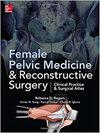Trends Among Female Pelvic Medicine and Reconstructive Surgery Fellowships and Graduates
IF 1.4
4区 医学
Q3 OBSTETRICS & GYNECOLOGY
Female Pelvic Medicine and Reconstructive Surgery
Pub Date : 2022-04-15
DOI:10.1097/SPV.0000000000001186
引用次数: 0
Abstract
Importance Understanding differences in female pelvic medicine and reconstructive surgery (FPMRS) urology and gynecology-based fellowships is important because both are accredited by the American Board of Medical Subspecialties. Objective The aim of the study was to characterize urology-based and gynecology-based FPMRS fellowships. Material and Methods An institutional review board–approved 21-item survey was emailed to Accreditation Council for Graduate Medical Education-accredited FPMRS fellowship program directors from January 8 through March 9, 2021. The survey aimed to characterize fellowships through a series of common and specialty-specific questions. Responses were collected with Qualtrics and analyzed using STATA/MP Version 16.1. Results The response rate was 75% (52/69). Many programs accept both gynecology- and urology-trained applicants (urology-based fellowships, 45.4%; gynecology-based fellowships, 68.3%) since the Accreditation Council for Graduate Medical Education accreditation in 2012. Within the gynecology-based cohort, there have been 10 urology-trained graduates among 7 programs (n = 1–2). Barriers to accepting urology applicants were limited gynecologic knowledge/experience (n = 14) and length of training (n = 11). Thirty-seven (94.8%) reported their graduates log more than 30 hysterectomies and 8.3% (n = 3) log 3 or more urinary diversions. Within the urology-based cohort, there have been 16 gynecology-trained graduates among 4 programs (n = 2–7). Lack of urologic clinical knowledge (n = 4) and training length (n = 2) were cited as barriers to accepting gynecology-trained applicants. Three (27%) reported that their graduates log more than 30 hysterectomies, while 8 (72.7%) reported that graduates log 3 or more urinary diversions. Conclusions Despite many FPMRS programs stating that they accept gynecology or urology-trained applicants, few fellows graduate from outside specialty FPMRS training programs. Several barriers were identified that may prevent trainees acceptance outside of their residency specialty. Procedural training experience differs between urology- and gynecology-based fellowships.女性盆腔医学和重建外科研究员和毕业生的趋势
重要性了解女性盆腔医学和重建外科(FPMRS)泌尿外科和妇科研究金的差异很重要,因为这两项研究金都得到了美国医学子专业委员会的认可。目的研究以泌尿外科和妇科为基础的FPMRS研究金的特点。材料和方法机构审查委员会批准的21项调查于2021年1月8日至3月9日通过电子邮件发送给研究生医学教育认证委员会认可的FPMRS研究金项目主任。该调查旨在通过一系列常见问题和特定专业问题来描述研究金的特点。使用Qualtrics收集响应,并使用STATA/MP版本16.1进行分析。结果有效率为75%(52/69)。自2012年研究生医学教育认证委员会认证以来,许多项目同时接受妇科和泌尿外科培训的申请人(泌尿外科奖学金,45.4%;妇科奖学金,68.3%)。在以妇科为基础的队列中,7个项目中有10名受过泌尿外科培训的毕业生(n=1-2)。接受泌尿外科申请者的障碍是妇科知识/经验有限(n=14)和培训时间(n=11)。37人(94.8%)报告他们的毕业生记录了30次以上的子宫切除术,8.3%(n=3)记录了3次或3次以上的尿路改道。在以泌尿外科为基础的队列中,4个项目中有16名受过妇科培训的毕业生(n=2-7)。缺乏泌尿外科临床知识(n=4)和培训时间(n=2)被认为是接受妇科培训申请人的障碍。三名(27%)的毕业生报告称,他们的毕业生进行了30多次子宫切除术,而八名(72.7%)的毕业生则报告说,他们进行了3次或3次以上的尿液改道。结论尽管许多FPMRS项目表示接受妇科或泌尿外科培训的申请人,但很少有研究员从专业外的FPMRS培训项目毕业。发现了一些障碍,这些障碍可能会阻碍学员在实习专业之外接受培训。泌尿外科和妇科奖学金的程序培训经验不同。
本文章由计算机程序翻译,如有差异,请以英文原文为准。
求助全文
约1分钟内获得全文
求助全文
来源期刊

Female Pelvic Medicine and Reconstructive Surgery
OBSTETRICS & GYNECOLOGY-
CiteScore
2.10
自引率
12.50%
发文量
228
期刊介绍:
Female Pelvic Medicine & Reconstructive Surgery, official journal of the American Urogynecologic Society, is a peer-reviewed, multidisciplinary journal dedicated to specialists, physicians and allied health professionals concerned with prevention, diagnosis and treatment of female pelvic floor disorders. The journal publishes original clinical research, basic science research, education, scientific advances, case reports, scientific reviews, editorials and letters to the editor.
 求助内容:
求助内容: 应助结果提醒方式:
应助结果提醒方式:


